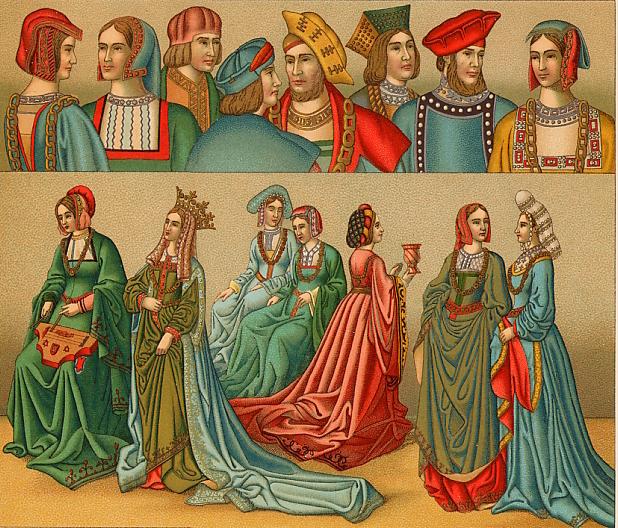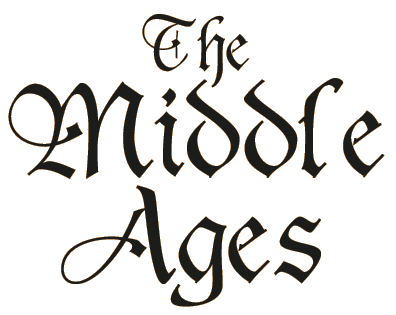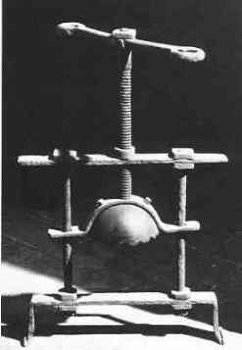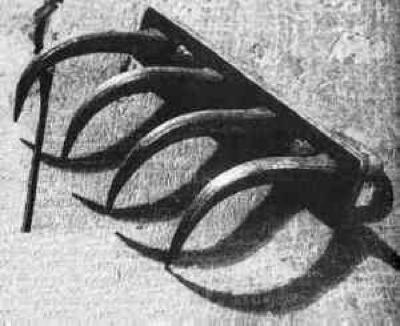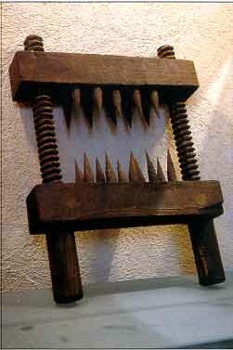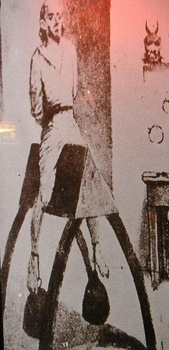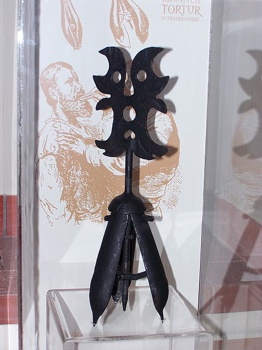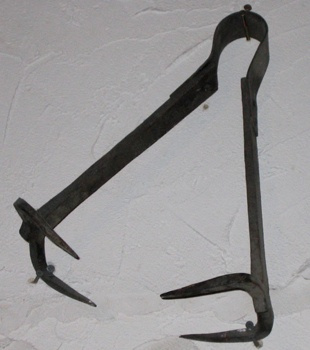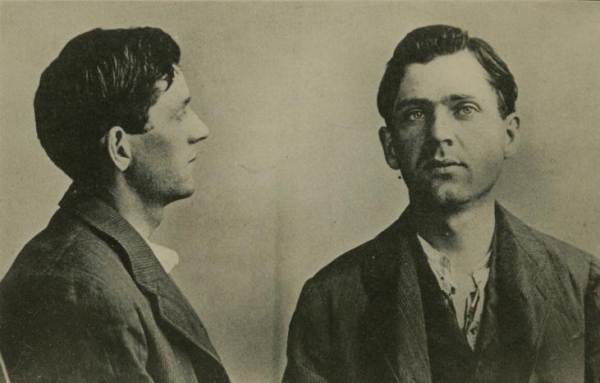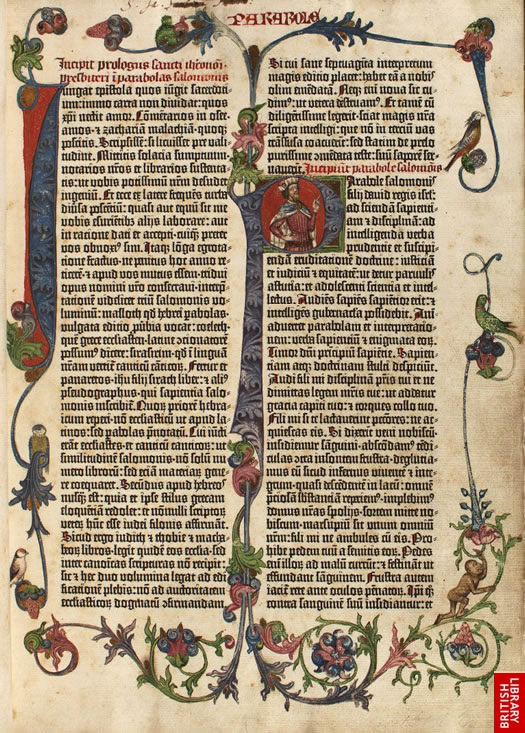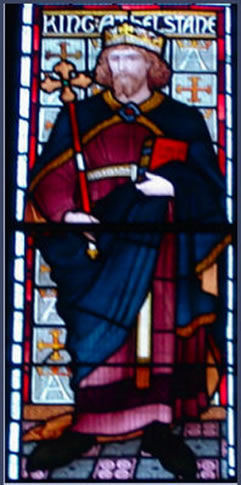The Middle Ages – 1066 -1485
The Middle Ages encompass one of the most turbulent periods in English History. Starting with the Battle of Hastings and the Norman Conquest – when William the Conqueror effectively took all of the lands from the Saxon English and gave them to French nobles. The English Middle Ages then saw the building of the great English castles, including the Tower of London, which helped the Normans to retain their hold on England. The start of the Crusades and the knights of the Middle Ages, including the founding of the Knights Templar. The Domesday Book and the Magna Carta. The Kings and Queens of the Middle Ages including Richard the Lionheart and great Plantagenet Kings from Henry II (1154-1189) to Edward III (1327-1377). The Hundred Years War between England and France. The Medieval Kings and Queens of the Royal Houses of Lancaster and York and the Wars of the Roses. The Middle Ages Feudal System and the terrible Black Death which really did plague the period of the Middle Ages.
The Medieval people of the Middle Ages were warlike, they have even been described as barbaric.The Crusades exposed the Europeans to a more refined culture. The elegance of the Far East, with its silks, tapestries, precious stones, perfumes, spices, pearls, and ivory prompted a change in culture with a new and unprecedented interest in beautiful objects and elegant manners. But meanwhile the battles for new territory and power raged on in Middle Ages History. The History of the Middle Ages covers the major historical events which occurred during the period from 1066 – 1485. The History of the Middle Ages starts in England with the Battle of Hastings in 1066 which ended the period classified as the Dark Ages. The events in Middle Ages History continues down the timeline until 1485 which ends the War of the Roses, the start of the Tudor dynasty and the emergence of the Renaissance.
Definition of the Middle Ages in England
The Middle Ages are so called as the middle period between the decline of the Roman Empire and the Renaissance. The early Middle Ages are often referred to as the Dark Ages. The Middle Ages are also referred to as the Medieval era.
Definition of the Middle Ages dates in England – 1066 – 1485
Their is some variance in the views and definition of the dates which encompassed the Middle Ages. We have included events in England from the Battle of Hastings in 1066 and ending in the emergence of the English Renaissance period with the Tudor dynasty in 1485. To put this into perspective, and for ease of reference, the periods in English history have been categorised as follows:
- Neolithic – Stone Age ( 3000 – 1800 BC )
- The Bronze & Iron Age ( 1800 – 600 BC )
- The Romans (600 BC – 410 AD)
- The Dark Ages – Anglo-Saxon England ( 410 AD – 1066 AD )
- The Middle Ages – 1066 – 1485
- The Renaissance Period in England starting with the Tudor Dynasty
Middle Ages Religion
Christianity, religion and the church played an important role in life in the Middle Ages. This section therefore provides interesting facts and information about the religious life in the Middle Ages including Religious Festivals, the Great Schism, The Great Schism, Daily Life of a Monk in the Middle Ages, Daily Life of a Nun in the Middle Ages, Medieval Monks, Medieval Nuns, the Anchoress and Anchorite, Monasticism, the Benedictine Rule, Benedictine Monks, a Medieval Monastery and a Medieval Convent or Nunnery.
The History of the Middle Ages with Timelines, Key dates and Events
The facts and information provided via the Middle Ages website provide access to the most important historical events of the period which are detailed in the pages about the Domesday Book, Black Death, Magna Carta, Battle of Hastings, Wars of the Roses, the One Hundred Years War and the Bayeux Tapestry. The History and Key Events of the Middle Ages included:
- The Battle of Hastings and the Norman Conquest
- The Bayeux Tapestry
- The Doomsday Book ( aka Domesday Book )
- The Magna Carta
- The Hundred Years War between England and France
- The Black Death
- The Wars of the Roses and the Battle of Bosworth
- The Great Schism of 1054 and the Great Western Schism
Middle Ages – Crusades in the Middle Ages
Pilgrimages to Jerusalem were made by people in the Middle Ages who had been guaranteed their safety in the city. In 1065 Jerusalem was taken by the Turks and Christians were treated so badly that throughout Christendom people were stirred to fight in crusades.
Middle Ages Knights
The Middle Ages was dominated by the feudal system and the role of the knights and their servants. Their life, living conditions, clothing, weapons, training, armor, tournaments and jousts. The Knights Templar organisation was also formed during the Middle Ages. Knighthood Training.
Knights Templar
The crusades saw the emergence of religious knights including the Knights Templar, the Teutonic knights and the Hospitallers. The members of the orders of Religious knights were both monks and knights; that is, to the monastic vows of chastity, poverty, and obedience they added a fourth vow, which bound them to protect pilgrims and fight the infidels.
Middle Ages Weapons
Every man was expected to be able to use weapons during the Middle Ages. There were basically two types of armed men during the Medieval era – The Knights and the Foot soldiers, who included the Archers. Middle Ages weapons and the training of soldiers during the Middle Ages including a Knights Weapons, the Quintain, Pell Training, Pell Mell and the Butts. The Medieval Shields and the Medieval Swords including the Broadsword, the Falchion sword, the Greatsword, the Longsword and the Scimitar. The different types of Polearms that were used as weapons during the Middle Ages including the Lance, the Halberd, the Pike, the Poleaxe and Spears.
Medieval Siege Weapons used during the Middle Ages
Medieval Siege Weapons used during the Middle Ages were the Ballista, Catapult, Mangonel, Battering Ram, Siege Tower and the awesome Trebuchet.
Middle Ages Castles
Development and Architecture of Middle Ages Castles, Famous Middle Ages Castles, Middle Ages Castles built by the Normans, Motte and Bailey castles, Middle Ages Concentric Castles built by King Edward I and Defending, Destroying and Attacking Middle Ages Castles.
Middle Ages Torture
We are all horrified and at the same time fascinated by Middle Ages torture. The castles of the Middle Ages with their dark dungeons increase the growing curiosity about torture during the Middle Ages. The torture chambers and the various torture devices used during the Middle Ages are described in this section including the Rack Torture, Scavengers Daughter, The Brank or Scold’s Bridle, Ducking Stool, Torture by Dislocation, Iron Balls Torture, Water Torture, The Boot Torture, Branding and Burning Tortures, Brodequins, Thumbscrews and the Pillory. Different types of execution methods are also described including being Burned at the Stake, Execution by Quartering, Execution by the Wheel, Execution by Hanging and being Hung, Drawn and Quartered.
Top 10 Gruesome Medieval Torture Devices
by Jamie Frater
Torture: it is an ancient practice that still goes on today. In the middle ages torture was used for punishment, interrogation, and deterrence. It is easy to consider ourselves more humane these days, but while some of the devices listed here would lead to death, we have, in modern times, mastered the ability of inflicting extreme pain for indefinite periods of time – something which is, perhaps, worse.
[accordion]
[accordion_pane accordion_title=”Head Crusher”]
With the head placed under the upper cap and the chin placed above the bottom bar, the top screw of this awful device was slowly turned, compressing the skull tightly. First the teeth are destroyed, shattering and splintering into the jaw. Then the eyes are squeezed from the sockets – some versions had special receptacles to catch them. Lastly, the skull fractures and the contents of the head are forced out. In earlier stages, the torturer could keep the head firmly clamped and strike the metal skull cap periodically; each blow echoing pain throughout the victim’s body.
[/accordion_pane]
[accordion_pane accordion_title=”The Cat’s Paw”]
The Cat’s Paw (or Spanish Tickler) was oftentimes attached to a handle; in size and appearance it was an extension of the torturer’s hand. In this way it was used to rip and tear flesh away from the bone, from any part of the body.
[/accordion_pane]
[accordion_pane accordion_title=”Knee Splitter”]
A popular torture device during the Inquisition, the knee splitter does what it says: split victims’ knees and render them useless. Built from two spiked wood blocks, the knee splitter is placed on top of and behind the knee of its victims. Two large screws connecting the blocks are then turned, causing the two blocks to close towards each other and effectively destroy a victim’s knee. This device could also be used to inflict damage on other parts of the body such as the arms.
[/accordion_pane]
[accordion_pane accordion_title=”Scavenger’s Daughter”]
The Scavenger’s Daughter was invented as an instrument of torture in the reign of Henry VIII by Sir William Skevington (also known as William Skeffington), Lieutenant of the Tower of London. It was an A-frame shaped metal rack to which the head was strapped to the top point of the A, the hands at the mid-point and the legs at the lower spread ends; swinging the head down and forcing the knees up in a sitting position so compressed the body as to force the blood from the nose and ears. The Scavenger’s Daughter was conceived as the perfect complement to the Duke of Exeter’s Daughter (the rack) because it worked the opposite principle to the rack by compressing the body rather than stretching it.
[/accordion_pane]
[accordion_pane accordion_title=”Judas Chair”]
This procedure has remained essentially unchanged from the Middle Ages until today. The victim is hoisted up and lowered onto the point of the pyramid in such a way that his weight rests on the point positioned in the anus, in the vagina, under the scrotum or under the coccyx (the last two or three vertebrae). The executioner, according to the pleasure of the interrogators, can vary the pressure from zero to that of total body weight. The victim can be rocked, or made to fall repeatedly onto the point. The Judas cradle was thus called also in Italian (culla di Giuda) and German (Judaswiege), but in French it was known as la veille, “the wake” or “nightwatch”. Nowadays this method enjoys the favour of not a few governments in Latin America and elsewhere, with and without improvements like electrified waist rings and pyramid points. Similar to the Judas Chair – but probably worse, is the Spanish Donkey:
[/accordion_pane]
[accordion_pane accordion_title=”Spanish Donkey”]
The Spanish Donkey was a device which consisted of a main board cut with a wedge at the top fastened to two cross-beams. The naked victim was placed astride the main board as if riding a donkey, and various numbers of weights were attached to his or her feet. The agony could be ‘fine-tuned’ by using lighter or heavier weights. Sources relate that on occasion, the wedge would slice entirely through the victim as a result of the immense weight attached to his or her feet.
[/accordion_pane]
[accordion_pane accordion_title=”Choke Pear”]
These instruments were used in oral and rectal formats, and in the larger vaginal one. They are forced into the mouth, rectum or vagina of the victim and there expanded by force of the screw to the maximum aperture of the segments. The inside of the cavity in question is irremediably mutilated, nearly always fatally so. The pointed prongs at the end of the segments serve better to rip into the throat, the intestines or the cervix. The oral pear was often inflicted on heretical preachers, but also on lay persons guilty of unorthodox tendencies; the rectal pear awaited passive male homosexuals, and the vaginal one women guilty of sexual union with Satan or his familiars. Pictured above is a version of the choke pear called the “Pear of Anguish”.
[/accordion_pane]
[accordion_pane accordion_title=”Lead Sprinkler”]
The lead sprinkler was essentially a ladle on the end of a handle. The top half of the sphere could be removed and the lower half was filled with molten metal, boiling oil, boiling water, pitch or tar. The perforated top half was then re-attached. Shaking or flicking the sprinkler towards the victim showered him or her with the boiling contents of the ladle. The victim had, of course, been pinioned in advance.
[/accordion_pane]
[accordion_pane accordion_title=”Breast Ripper”]
This item was used both as a punitive and an interrogational device. Punitively, it was used red-hot to mark the breast of unmarried mothers. In an inquisitory nature it was used on condemned women – convicted of heresy, blasphemy, adultery, self-induced abortion, erotic white magic and any other crime that the inquisitors selected. The claws were used, either cold or heated, on a female’s exposed breasts – rendering them into bloody pulps. A variation was called the Spider. This consisted of clawed bars which protruded from the wall. A woman was pulled alongside the bars until her breasts were torn away.
[/accordion_pane]
[accordion_pane accordion_title=”Crocodile Shears”]
The crocodile shears was an instrument of torture used in late medieval Europe and typically reserved for regicides – those who attempted (and, perhaps, succeeded) to assassinate the king. The shears were made of iron and were based upon the concept of pincers, but—instead of standard jaws or blades, crocodile shears ended in a pair of hemicylindrical blades that, when closed together, formed a long, narrow tube. The insides of the blades were generously lined with teeth or spikes. After being heated red-hot, the crocodile shears were applied to the erect penis, which—once exposed to sufficient tension—was torn from the prisoner’s body; or at the very least leading to severe arterial bleeding.
[/accordion_pane]
[/accordion]
Middle Ages – History of the Famous People
Famous Middle Ages people and details of the key dates and events in their lives. Famous Middle Ages people include great nobles, religious leaders, artists, scientists, military leaders, inventors and explorers including:
- Marco Polo – famous explorer
- Kublai Khan – Mongol leader and Emperor of China in he Middle Ages
- Johann Gutenberg- famous inventor
- Frederick Barbarossa – King of Germany and Crusader
- Joan of Arc – Lead France to victory during the Hundred Years War
- Peter the Hermit – Religious Crusader
- Robert the Bruce – Famous King of Scotland
- William Wallace – Braveheart hero of Scotland
- Thomas Becket – Saint and Archbishop of Canterbury
- Thomas Aquinas – One of the greatest theologians of the Catholic Church
- Roger Bacon – Scientist, inventor and philosopher
- Jack Cade – Leader of English rebellion
- Lambert Simnel – A pretender to the throne of England
- Perkin Warbeck – A pretender to the throne of England
- El Cid – Famous Spanish hero
- Tamerlane – Leader of the Monguls
- William Tell – hero of Switzerland
- John of Gaunt – famous Plantagenet Prince
- Peter Abelard – Medieval Scholar and lover of Heloise
- Blondel the Minstrel – the famous Medieval minstrel of legend
Other famous people include Geoffrey of Monmouth, Saladin, Robin Hood, Donatello, Godfrey of Bouillon, Tancred de Hauteville, Giotto di Bondone, Hereward the Wake, Albertus Magnus, Leon Battista Alberti, Erasmus, Jan Hus, Cimabue, John Wycliffe, King Louis IX, William of Ockham, Vlad Dracula and Simon de Montfort. Famous Middle Ages people include great nobles, religious leaders, artists, scientists, military leaders, inventors and explorers – the Medieval heroes and villains.
Middle Ages Clothing
Middle Ages clothing and fashion like everything else was dictated by the Pyramid of Power which was the Middle Ages Feudal System. Medieval clothes provided information about the status of the person wearing them. Sumptuary Laws of the Middle Ages, History of Fashion in the Middle Ages, Medieval Fashion, Middle Ages Ladies Dresses, Medieval Knight Clothing, Medieval Lord Clothing, Medieval Peasant Clothing, Medieval Kings Clothing, Medieval Women’s Clothing, Monks Clothes in the Middle Ages, Nuns Clothes in the Middle Ages, Simple Dresses from the Middle Ages, Middle Ages Hairstyles
Middle Ages clothing and fashion like everything else was dictated by the Pyramid of Power which was the Middle Ages Feudal System. Medieval clothes provided information about the status of the person wearing them.
Middle Ages Clothing in Europe
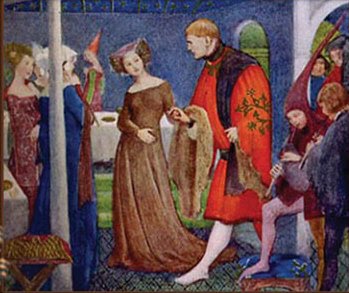 Amongst European nations, during the Middle Ages, there was always one common standard of fashion and clothing , which varied from time to time according to the particular custom of each country, and according to the peculiarities of each race. Each European country would imitate the fashions and clothing of another but still manage to retain its own identity. In Italy, for instance, clothing and dress always maintained a certain character of grandeur, ever recalling the fact that the influence of antiquity was not quite lost. In Germany and Switzerland, clothing and garments had generally a heavy and massive appearance; in Holland, still more so. England uniformly studied a kind of instinctive elegance and propriety in clothing. It is a curious fact that Spain invariably partook of the heaviness of clothing peculiar to Germany because the Gothic element still prevailed there. France was fickle and capricious, always ready to borrow from every quarter any style of clothing which pleased her.
Amongst European nations, during the Middle Ages, there was always one common standard of fashion and clothing , which varied from time to time according to the particular custom of each country, and according to the peculiarities of each race. Each European country would imitate the fashions and clothing of another but still manage to retain its own identity. In Italy, for instance, clothing and dress always maintained a certain character of grandeur, ever recalling the fact that the influence of antiquity was not quite lost. In Germany and Switzerland, clothing and garments had generally a heavy and massive appearance; in Holland, still more so. England uniformly studied a kind of instinctive elegance and propriety in clothing. It is a curious fact that Spain invariably partook of the heaviness of clothing peculiar to Germany because the Gothic element still prevailed there. France was fickle and capricious, always ready to borrow from every quarter any style of clothing which pleased her.
Middle Ages Women and Medieval Queens and Princesses
The lives of Middle Ages women were dependent on their role and status. All women were expected to be subservient to the men in their family. What were the daily lives of Middle Ages women like and were women’s rights during the Middle Ages? Medieval Queens and Princesses. Famous Noble women such as Matilda of Flanders, Good Queen Maude, Queen Matilda, Queen Matilda of Boulogne, Eleanor of Aquitaine, Queen Berengaria of Navarre, Isabelle of Angouleme, Eleanor of Provence, Eleanor of Castile, Isabella of France, Philippa of Hainault, Mary de Bohun, Catherine of Valois, Margaret of Anjou, Elizabeth Woodville and Anne Neville. The names of famous Medieval women scatter the History books – they were mostly queens and princesses. But what about the women who were not of noble birth? Learn about the Medieval Mystics and the Mistresses, the Rich and the poor women of the Middle Ages. including Anna Comnena, Heloise, Hildegard of Bingen, Julian of Norwich, Christine de Pizan, Jane Shore, Alice Perrers, Katherine Swynford and Margery Kempe.
Middle Ages – Middle Ages Food
The people of the Middle Ages loved their food and drink. What food was consumed by the Upper and Lower class Middle Ages?
Middle Ages Food changed considerably during the Middle Ages. Up to the start of the Middle Ages when William the Conqueror and the Normans invaded England the only real influence on the types of food consumed had been from the Romans. The violent times of the Dark Ages led to a primitive society lacking in elegance or refinement. Early Middle Ages Food was basic and the ingredients were home grown. This all changed in 1066 with the Norman Conquest and between 1095 – 1270 when Europeans looked to the Eastern World and joined in the crusades.
Middle Ages Drink
The people of the Middle Ages enjoyed to drink, and as water was often unclean, it was a necessity. The poor drank ale, mead or cider and the rich were able to drink many different types of wines
Middle Ages Food – Recipe Books
The French produced the first Recipe books. In 1306 ‘The Little Treatise’ was written. The first English cookery book was written in 1390 called ‘The Forme of Cury’ which consisted of nearly 200 recipes 196 recipes contributed by the Royal cooks. Facts and information about the different types of foods eaten during the Middle Ages Medieval period including the meat, fruit, fish and bread.
The Influence of the Normans on Middle Ages Food
The Normans were influenced by French food and also Scandinavian food. The Normans were known to document recipes although generally they passed form the master cook to the apprentice. The tastes of the Norman nobility were far more sophisticated than the English. The Normans also enjoyed feasts and special occasions when lavish meals and food could be served.
The Influence of the Crusades on Middle Ages Food
The influence of the Crusades had a startling effect on Middle Ages Food. Kings, Knights, Lords and other crusaders had travelled 3000 miles to reach the Holy Lands. And during their travels they were introduced to the spices which were added to different foods by different cultures. These new ideas about Middle Ages food were brought back by the Crusaders and new foods and spices were introduced to the European menu.
A culture change influences Middle Ages Food

Black Death
The Black Death was one of the most devastating pandemics in human history, peaking in Europe between 1348 and 1350, and killing between 75 million and 200 million people.
The elegance of the Far East, with its silks, tapestries, precious stones, perfumes, spices, pearls, and ivory, was so enchanting that an enthusiastic crusader called it “the vestibule of Paradise”. A change in culture started to emerge. Travel certainly broadened the mind of the Crusaders who developed a new and unprecedented interest in beautiful objects and elegant manners. It must be remembered that the preparation of Middle Ages Food was of special interest to the women of the era, many of whom accompanied men on the Crusades. The preparation and content of Middle Ages food underwent a ‘sea change – into something rich and strange’.
A change in the economy influenced Middle Ages Food
The economy of the Middle Ages changed. Various goods were exported from the Far East including spices. It became a status symbol to serve food with herbs and spices. As they were exported, these spices were expensive. The differences of The Middle Ages Food consumed by the Upper and Lower Classes changed significantly. The poor could not afford the new range of spices. Middle Ages Food varied according to status and according to the Middle Ages period. And in the early Middle Ages era even meat was a sign of wealth.
Middle Ages Food and the Black Death
The amount of food available in the Middle Ages world changed in 1328. The Black Death spread across Europe with devastating effect. The population of the Middle Ages dropped – the Black Death claimed a third of the World’s population and 200 million people died. The Black Death reached England by 1346 and ravaged the land for nearly 60 years. The Black Death resulted in a far smaller population, more food was available and even the poor were able to eat meat.
Kings in the Middle Ages
The Normans ruled the English after their victory at the Battle of Hastings. Norman Kings, and even a Queen, of the Middle Ages :
- William the Conqueror
- King William Rufus
- King Henry I
- Queen Matilda
- King Stephen
- From 1154 – 1377 the Plantagenet Kings of England ruled the English during the Middle Ages. There are biographies and timelines detailing the lives and story of the following Kings in the Middle Ages:
- King Henry II
- King Richard I
- King John
- King Henry III
- King Edward I
- King Edward II
- King Edward III
- From 1377 – 1485 the Royal Houses of Lancaster and York became Kings of England in the Middle Ages and ruled the English. There are biographies and timelines detailing the lives and story of Kings in the Middle Ages and the War of the Roses:
- King Richard II
- King Henry IV
- King Henry V
- King Henry VI
- King Edward IV
- Edward V – One of the little Prices in the Tower
- King Richard III
The Knights Templar
 The order of the Knights Templar is synonymous with the crusades of the Middle Ages. This section of the Middle Ages details the emergence of the Religious knights, their achievements, accomplishments and their decline on Friday the 13th, in October 1307 when Jacques de Molay, the Grand Master of the Knights Templar, and 60 of his senior knights were arrested in Paris. This day is remembered in history – it is the reason Friday 13th is deemed to be unlucky.
The order of the Knights Templar is synonymous with the crusades of the Middle Ages. This section of the Middle Ages details the emergence of the Religious knights, their achievements, accomplishments and their decline on Friday the 13th, in October 1307 when Jacques de Molay, the Grand Master of the Knights Templar, and 60 of his senior knights were arrested in Paris. This day is remembered in history – it is the reason Friday 13th is deemed to be unlucky.
Religious Knights
The crusades saw the emergence of religious knights including the Knights Templar, the Teutonic knights and the Hospitallers. The members of the orders of Religious knights were both monks and knights; that is, to the monastic vows of chastity, poverty, and obedience they added a fourth vow, which bound them to protect pilgrims and fight the infidels.
Templar Knights
The Middle Ages saw the emergence of a military order called the Poor Fellow-Soldiers of Christ and of the Temple of Solomon. Their name was to become the Templar Knights, or the Knights Templar.
Knights Templar History
The Knights Templar History started with the crusades of the Middle Ages, a war between Christians and Moslems centered around the city of Jerusalem. The Medieval order of the Knights Templar was dissolved in 1312 by the Council of Vienne.
Knights Templar Banking
When a man joined the Knights Templar he took an oath of poverty and his wealth and lands were donated to the Knights Templar order. Donations of money and land were also given to the Knights Templar order by nobles and Kings. The Knights Templar order therefore became extremely wealthy and became involved in Knights Templar Banking activities.
Knights Templar Timeline
The Knights Templar timeline charts the key dates of the people and events surrounding the Knights Templar order.
The timeline starts during the Roman period and the discovery of the Holy Sepulchre in Jerusalem. The timeline then goes on to first crusade and the founding of the Knights Templar Order. All of the Masters names are detailed in this Knights Templar timeline. Dates of all of the major events and people who were important to the Knights Templar order can be found in the timeline. Facts and information about the main events of the Knights Templar history can be found in many entries in the timeline.
| Events Summary Knights Templar Timeline |
Key Dates in the Knights Templar Timeline |
Major Events in the Knights Templar Timeline |
|
Knights Templar Timeline 330 – 1065 |
330 A.D. |
The mother of the Roman Emperor Constantine, discovered the Holy Sepulchre and her son built the Church of the Holy Sepulchre in Jerusalem |
| 330 – 637 | Pilgrims throughout the Middle Ages made sacred pilgrimages to the Holy city of Jerusalem | |
| 637 A.D. | Jerusalem was surrendered to the Saracens | |
| 637 |
The caliph of the Saracens called Omar gave guarantees for the safety of the Christian population – pilgrimages continued |
|
|
Knights Templar Timeline 1065 – 1118 |
1065 | Jerusalem was taken by the Turks – initiating the crusades of the Middle Ages. |
| 1099 |
Crusaders led by Godfrey of Bouillon took Jerusalem back from the Turks. The founding of the Knights Templar was initiated shortly after this date by Bernard of Clairvaux |
|
|
Knights Templar Timeline 1118 – 1150 |
1118 | King Baldwin II of Jerusalem, granted the Knights Templar a place to live within the sacred enclosure of the Temple on Mount Moriah. |
| 1118 | Hugh de Payens was chosen by the knights as the first master of the order | |
| 1127 | Hugh De Payen and the Knights Templar returned to France | |
| 1127 | The first donation of land was given to the Templars by Count Thybaud | |
| 1127 | Hugh de Payens was granted the land for the first Temple Church in Holborn, London | |
| 1128 | The ecclesiastical Council of Troyes was instigated by Bernard of Clairvaux and gave the Knights Templar official recognition | |
| 1130 | Knights Templar order received privileges from Alfonso I of Spain | |
| 1136 | Knights Templar Hugh de Payen died and was succeeded by Robert de Craon as Master of the Temple | |
| 1136 | The Knights Templar were awarded the wealthy manor of Cressing | |
| 1139 |
A Papal Bull was issued by Pope Innocent II stating that the Knights Templar should owe allegiance to none other than the Pope |
|
| 1146 |
Knights Templar Robert de Craon died and was succeeded by Everard des Barres as Master of the Temple |
|
| 1146 | The Knights Templar order adopted the splayed red cross as their emblem | |
| 1148 | The Knights Templar order supported the second crusade and assembled at Acre | |
| 1149 |
Everard des Barres dies and is succeeded by Bernard de Tremelay (1149-1153) |
|
|
Knights Templar Timeline 1150 – 1250 |
||
| 1153 | Bernard de Tremelay dies and is succeeded by André de Montbard (1153-1156) | |
| 1154 | The Grand Master of Knights Templar, André de Montbard, superintended the Masons in England and built their Temple in Fleet Street, London | |
| 1156 | André de Montbard dies and is succeeded by Bertrand de Blanchefort (1156-1169) | |
| 1169 | Bertrand de Blanchefort dies and is succeeded by Philippe de Milly (1169-1171) | |
| 1170 |
Richard de Hastings, the Master of the English Templars, attempted to reconcile the differences between King Henry II and Thomas Becket. Their attempts to reconcile the two parties failed and Thomas a Becket was murdered in Canterbury Cathedral |
|
| 1171 | Philippe de Milly dies and is succeeded by Odo de St Amand (1171-1179) | |
| 1179 | Odo de St Amand dies and is succeeded by Arnaud de Toroge (1179-1184) | |
| 1184 |
The army of Jerusalem and Guy of Lusignan, the King of Jerusalem, was beaten by Turkish forces and all Knights Templar who survived the battle were executed afterwards |
|
| 1184 | Arnaud de Toroge dies and is succeeded by Gérard de Ridefort in 1185 | |
| 1189 | Gérard de Ridefort dies and is succeeded by Robert de Sablé in 1191 | |
| 1191 | The city of Acre was taken by the Crusaders and the Knights Templars | |
| 1191 |
Robert de Sablé dies in 1191 and is succeeded by Gilbert Horal (1193-1200) |
|
|
Knights Templar Timeline 1250 – 1300 |
1200 | Gilbert Horal dies and is succeeded by Phillipe de Plessis (1201-1208) |
| 1208 | Phillipe de Plessis dies and is succeeded by Guillaume de Chartres (1209-1219) | |
| 1219 | Guillaume de Chartres and is succeeded by Pedro de Montaigu (1219-1230) | |
| 1230 | Pedro de Montaigu dies and is succeeded by Armand de Périgord (1232-1244) | |
| 1244 | Armand de Périgord dies and is succeeded by Richard de Bures (1245-1247) | |
| 1247 | Richard de Bures dies and is succeeded by Guillaume de Sonnac (1247-1250) | |
| 1250 | Guillaume de Sonnac is succeeded by Renaud de Vichiers (1250-1256) | |
| 1256 | Renaud de Vichiers is succeeded by Thomas Bérard (1256-1273) | |
| 1263 |
Problems in England lead to the Baron’s revolt led by Simon de Montford opposing the prince who becomes Edward I. Edward entered the Knights Templar Temple in London and ransacked the treasury |
|
| 1271 | Edward lead a crusade and was attacked by an assassin with a poisoned knife. He survived the attack and his life was saved with drugs sent by the Master of the Knights Templar, Thomas Bérard | |
| 1272 | King Henry III of England died and the English Council met at the Temple in London and draft a letter to Prince Edward informing him of his accession to the throne, illustrating the political importance of the Knights Templar in England | |
| 1272 | Thomas Bérard is succeeded by Guillaume de Beaujeu (1273-1291) | |
| 1291 | Guillaume de Beaujeu dies and is succeeded by Thibaud Gaudin (1291-1292) | |
| 1291 | The Knights Templar suffer a huge defeat at Acre and cease to be a strong fighting force | |
| 1292 |
Thibaud Gaudin is succeeded by Jacques de Molay (1292-1314) |
|
|
Knights Templar Timeline 1300 – 1314 |
1302 |
The Knights Templar recruited after the defeat at Acre are wiped out at Raud |
| 1307 | King Philip IV of France (1268-1314) who was already heavily in debt to the Knights Templar requested a further loan. The request was refused and King Philip ordered the arrest of all Knight Templars in France | |
| 1307 | 11 October Templar ships left La Rochelle, heading to Scotland with much of their wealth | |
| 1307 |
On Friday the 13th, in October , Jacques de Molay, the Grand Master of the Knights Templar, and 60 of his senior knights were arrested in Paris, France and charged with heresy. Many confessed under torture |
|
| 1307 |
Pope Clement V initiated enquiries into the order and thousands of Knights Templar were arrested across Europe |
|
| 1312 | The Medieval order of the Knights Templar become extinct when the order is dissolved by the Council of Vienne. | |
| 1312 | All the property owned by the Templars is transferred to the Knights of St. John ( The Hospitallers ) | |
| 1314 |
Jacques de Molay and Geoffroi de Charney were burnt at the stake on March 18th for rescinding their former admission of heresy |
Names of Knights Templar Leaders
The names of all of the Medieval leaders are detailed on this section together with the dates of their leadership as the Masters of the order.
The names of Knights Templar Leaders, the Grand Masters, are as follows:
- Hugh de Payens (1118-1136)
- Robert de Craon (1136-1146)
- Everard des Barres (1146-1149)
- Bernard de Tremelay (1149-1153)
- André de Montbard (1153-1156)
- Bertrand de Blanchefort (1156-1169)
- Philippe de Milly (1169-1171)
- Odo de St Amand (1171-1179)
- Arnaud de Toroge (1179-1184)
- Gérard de Ridefort (1185-1189)
- Robert de Sablé (1191-1193)
- Gilbert Horal (1193-1200)
- Phillipe de Plessis (1201-1208)
- Guillaume de Chartres (1209-1219)
- Pedro de Montaigu (1219-1230)
- Armand de Périgord (1232-1244)
- Richard de Bures (1245-1247)
- Guillaume de Sonnac (1247-1250)
- Renaud de Vichiers (1250-1256)
- Thomas Bérard (1256-1273)
- Guillaume de Beaujeu (1273-1291)
- Thibaud Gaudin (1291-1292)
- Jacques de Molay (1292-1314)
Teutonic Knights
The Teutonic Knights were a military-religious order of knights that restricted membership to Germans. Teutonic Knights were members of the order of the Teutonic Knights of the Hospital of the Blessed Virgin.
Knights Hospitaller
The Knights Hospitaller were Knights of the Order of Saint John the Hospitaller who were also known by such names as Knights of Rhodes, Knights of Malta. The Hospitallers grew out of a brotherhood for the care of sick pilgrims in a hospital at Jerusalem following the First Crusade in 1100 AD.
1066 – 1485 Timeline
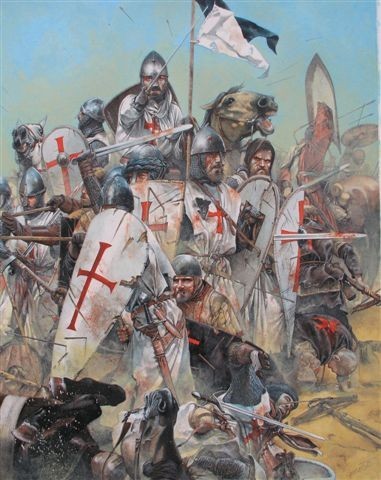 Middle Ages encompass one of the most exciting and bloodthirsty periods in English and European History. This comprehensive Middle Ages Timeline of the Medieval period details the major events significant to the lives and events of famous people and the Kings and Queens of England and Europe.
Middle Ages encompass one of the most exciting and bloodthirsty periods in English and European History. This comprehensive Middle Ages Timeline of the Medieval period details the major events significant to the lives and events of famous people and the Kings and Queens of England and Europe.
The Timeline of the early Middle Ages starts in 1066 with the Battle of Hastings and the Norman Conqest and ends in 1485 with the death of King Richard III at the Battle of Bosworth Field. This comprehensive Middle Ages Timeline details the major events significant to life during the Medieval era. The Timeline of covers all of the reigns of the Kings of England from the Normans to the Plantagenet’s culminating in the events surrounding the Wars of the Roses.
The great Medieval people of the Middle Ages are all featured in the timeline. Facts and information in the Middle Ages timeline about the Doomsday Book, Magna Carta, the Crusades, the Knights Templar, the Hundred Years War between England and France, the Black Death, the Wars of the Roses and the Battle of Bosworth Field. The Middle Ages timeline dates of all of the major events and people who were important to the Medieval era and times. Facts and information about key people and events such as Joan of Arc, John of Gaunt, Geoffrey Chaucer, Johann Gutenberg, Martin Luther, Saladin, Peter the Hermit, Marco Polo, Robert the Bruce and William Wallace – Braveheart are found in entries in the Middle Ages Timeline of the Medieval period.
The Middle Ages timeline covers the period of 1066 to 1485 – nearly five hundred years of the history of England and Europe. The facts and information in the Middle Ages Timeline have therefore been categorised in several Middle Ages Timelines under the following headings:
The following Middle Ages Timeline has been developed to provide an overview of the history and key dates in the Medieval period.
| Summary of Events Timeline | Timeline Key Dates | Middle Ages Timeline of Key events |
|
Middle Ages History Timeline 1066 -1154 |
1066-1087 | The reign of King William the Conqueror The Battle of Hastings and the defeat of Harold Godwinson The Building of Norman castles in England including the Tower of London in 1073 1086 – Compilation of the Doomsday book |
| 1087-1100 | The reign of King William Rufus (son of William) William invades Wales and builds castles on the borders |
|
| 1100-1135 | The reign of King Henry I (William Rufus brother) | |
| 1135-1154 | The reign of King Stephen (nephew of Henry I) 1099: First Crusade. Jerusalem is re-taken from the Muslims on the urging of Pope Urban II 1118: The Knights Templar founded to protect Jerusalem and European pilgrims on their journey to the city 1147: Second Crusade |
|
|
Middle Ages History Timeline 1154 – 1377 |
1154-1189 | The reign of King Henry II (grandson of Henry I) 1156: Kremlin built in Moscow 1158: The Hanseatic League is founded 1184: The first of many Inquisitions begins 1170: Thomas a Becket is murdered in Canterbury Cathedral |
| 1189-1199 | The reign of King Richard I (third son of Henry II) 1190: Third Crusade. Saladin manages to unite the Muslim world and recapture Jerusalem, sparking the Third Crusade |
|
| 1199-1216 | The reign of King John (fifth son of Henry II) 1200: Fourth Crusade embarks. Eventually sacks Constantinople 1212: Children’s Crusade 1214 -1215: Barons revolt 1215: Magna Carta is signed |
|
| 1216-1272 | The reign of King Henry III (son of John) 1258: Provisions of Oxford forced upon Henry III of England, establishing a new form of government limited regal authority |
|
| 1272-1307 | The reign of King Edward I (son of Henry III) 1273: Rudolph I of Germany is elected Holy Roman Emperor 1274: Thomas Aquinas’ work, Summa Theologiae is published 1295: Marco Polo publishes his tales of China 1297: William Wallace emerges as the leader of the Scottish resistance to England |
|
| 1307-1327 | The reign of King Edward II (son of Edward I) 1307: The Knights Templar are rounded up and murdered by Philip the Fair of France, with the backing of the Pope 1311-1315: The Great Famine |
|
| 1327-1377 | The reign of King Edward III (son of Edward II) 1337: The Hundred Years War begins. England and France struggle for dominance of Western Europe 1346: Battle of Crecy 1347: The Black Death ravages Europe for the first of many times. An estimated 20% – 40% of the population is thought to have perished within the first year 1356: Battle of Poitiers |
|
|
Middle Ages History Timeline 1377 – 1485 |
1377-1399 | The reign of King Richard II (grandson of Edward III, son of the Black Prince) 1380: Chaucer begins to write The Canterbury Tales 1381: Peasants Revolt in England 1382: The Bible is translated into English by John Wycliffe. |
| 1399-1413 | The reign of King Henry IV (grandson of Edward III, son of John of Gaunt) | |
| 1413-1422 | The reign of King Henry V (son of Henry IV) 1415: Battle of Agincourt |
|
| 1422-1461 | The reign of King Henry VI (son of Henry V) 1429: Joan of Arc lifts the siege of Orleans for the Dauphin of France, enabling him to eventually be crowned at Reims 1430: Capture, trial, and execution of Joan of Arc 1434: The Medici family rises to prominence in Florence 1452: Leonardo da Vinci is born 1453: The Hundred Years War ends. Calais is the only English possession on Continental Europe 1455: Johann Gutenberg prints the first of his Bibles on his new printing press 1455: The Wars of the Roses begins in England |
|
| 1461-1483 | The reign of King Edward IV ( youngest son of Edward III) William Caxton sets up a printing press in Westminster |
|
| 1483-1485 | The reign of King Richard III (uncle of Edward V) 1485: The Wars of the Roses ends and the Tudor dynasty begins |
|
Author: Alchin, L.K.
Name of Website: The Middle Ages http://www.middle-ages.org.uk/
Retrieved : e.g. November 16 2012

